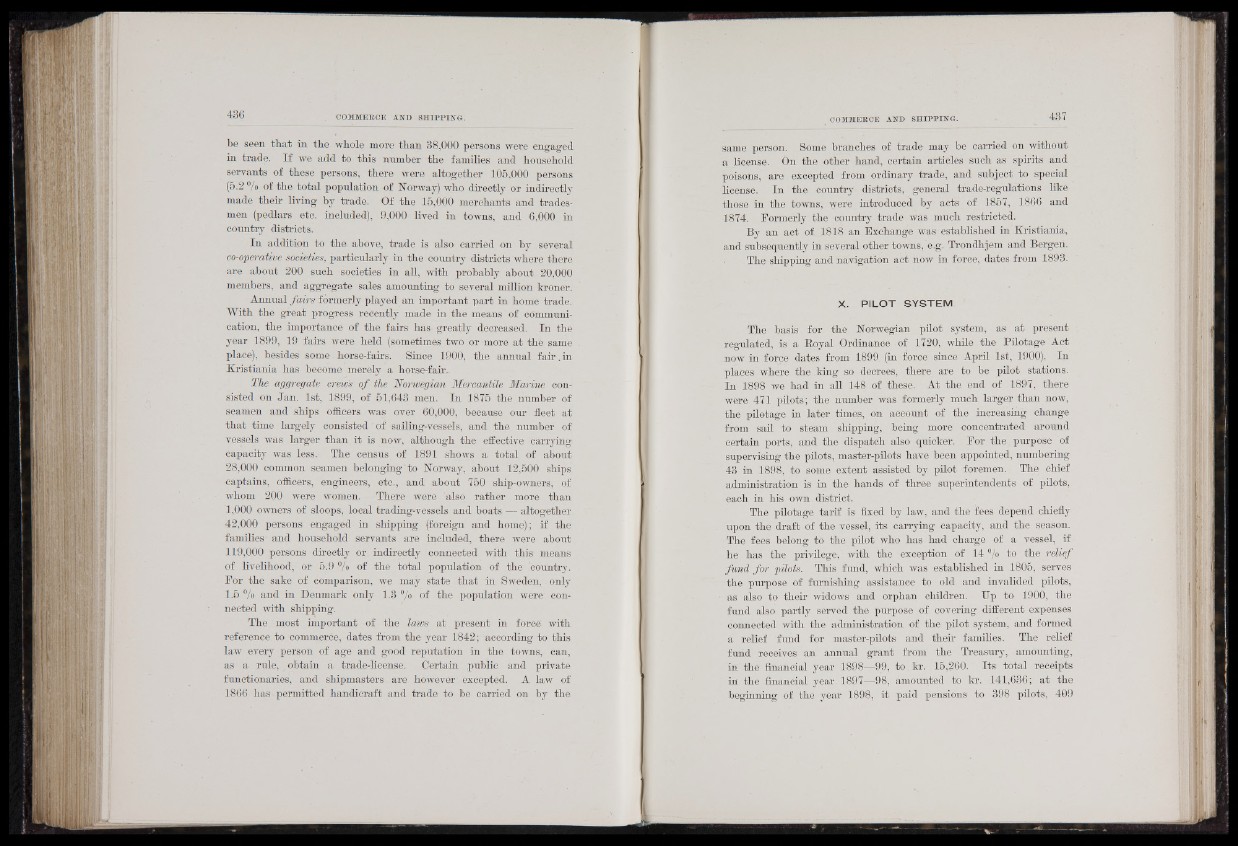
be seen that in the whole more than 38,000 persons were engaged
in trade. If we add to this number the families and household
servants of these persons, there were altogether 105,000 persons
(5.2 °/o of the total population of Norway) who directly or indirectly
made their living by trade. Of the 15,000 merchants and tradesmen
(pedlars etc. included), 9,000 lived in towns, and 6,000 in
country districts.
In addition to the above, trade is also carried on by several
co-operative societies, particularly in the country districts where there
are about 200 such societies in all, with probably about 20,000
members, and aggregate sales amounting to several million kroner.
Annual fairs formerly played an important part in home trade.
With the great progress recently made in the means of communication,
the importance of the fairs has greatly decreased. In the
year 1899, 19 fairs were held (sometimes two or more at thé same
place), besides some horse-fairs. Since 1900, the annual fa ir. in
Eristiania has become merely a horse-fair.
The aggregate crews of the Norwegian Mercantile Marine consisted
on Jan. 1st, 1899, of 51,643 men. In 1875 the number of
seamen and ships officers was over 60,000, because our fleet at
that time largely consisted ' of sailing-vessels, and the number of
vessels was larger than it is now, although the effective carrying
capacity was less. The census of 1891 shows a total of about
28.000 common seamen belonging to Norway, about 12,500 ships
captains, officers, engineers, etc., and about 750 ship-owners, of
whom 200 were women. There were also rather more than
1.000 owners of sloops, local trading-vessels and boats — altogether.
42.000 persons engaged in shipping (foreign and home); if the
families and household servants are included, there were about
119,0.00 persons directly or indirectly connected with this means
of livelihood, or 5.9% of the total population of the country.
For the sake of comparison, we may state that in Sweden, only
1.5 % and in Denmark only 1.3 % of the population were connected
with shipping.
The most important of the laws at present in force with
reference to commerce, dates from the year 1842; according to this
law every person of age and good reputation in the towns, can,
as a rule, obtain a trade-license. Certain public and private
functionaries, and shipmasters are however excepted. A law of
1866 has permitted handicraft and trade to be carried on by the
same person. Some branches of trade may be carried on without
a license. On the other hand, certain articles such as spirits and
poisons, are excepted from ordinary trade, and subject to special
license. In the country districts, general trade-regulations like
those in the towns, were introduced by acts of 1857, 1866 and
1874. Formerly the country trade was much restricted.
By an act of . 1818 an Exchange was established in Eristiania,
and subsequently in several other towns, e.g. Trondhjem and Bergen.
The shipping and navigation act now in force, dates from 1893.
X. PILOT SYSTEM.
The basis for the Norwegian pilot system, as at present
regulated, is a Royal Ordinance of 1720, while the Pilotage Act
now in force dates from 1899 (in force since April 1st, 1900), In
places where the king so decrees, there are to be pilot stations.
In 1898 we had in all 148 of these. At the end of 1897, there
were 471 pilots; the number was formerly much larger than now,
the pilotage in later times, on account of the increasing change
from sail to steam shipping, being more concentrated around
certain ports, and the dispatch also quicker. For the purpose of
supervising the pilots, master-pilots have been appointed, numbering
43 in 1898, to some extent assisted by pilot foremen. The chief
administration is in the hands of three superintendents of pilots,
each in his own district.
The pilotage tarif is fixed by law, and the fees depend chiefly
upon the draft of the vessel, its carrying capacity, and the season.
The fees belong to the pilot who has had charge of a vessel, if
he has the privilege, with the exception of 14 % to the relief
fund for pilots. This fund, which was established in .1805, serves
the purpose of furnishing assistance to old and invalided pilots,
as also to their widows and orphan children. Up to 1900, the
fund also partly served the purpose of covering different expenses
connected with the administration of the pilot system, and formed
a relief fund for master-pilots and their families. The relief
fund receives an annual grant from the Treasury, amounting,
in the financial year 1898—99, to , kr. 15,260. Its total receipts
in the financial year. 1897—98, amounted to kr. 141,636; at the
beginning of the year 1898, it paid pensions to 398 pilots, 409